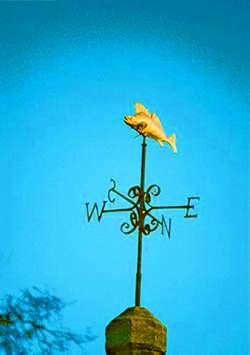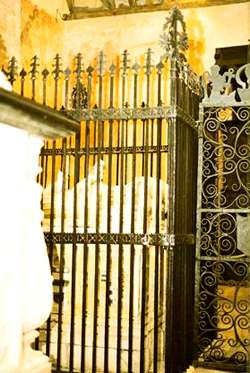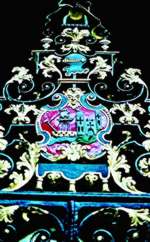Wrought Ironwork
The term 'wrought ironwork' is often loosely used to mean decorative forged
metalwork, including steelwork. Elaborate gates and railings immediately
spring to mind. However, not all wrought ironwork is decorative, and steel,
which was only introduced in 1856, is a very different material in both
form and performance.
As the oldest form of iron to be used, wrought iron is the material which
gave the Iron Age its name. Architecturally its importance for fixings
and fastenings was established long before the need for railings and decorative
balustrades materialised, and some of the oldest examples of wrought ironwork
include nails and spikes as well as agricultural implements and arms.
However its decorative potential was also recognised and some of the earliest
examples of the material's use include jewellery.
 |
|
| An early wrought iron weather vane in Bradford on Avon, Wiltshire, believed to date from the early 17th century |
Many wonderful examples of medieval wrought
ironwork survive in churches, houses and other buildings throughout Britain,
including huge wrought iron hinges, simply ornamented latches and heavy
drop handles. 17th century window catches were often given fleur-de-lys
back plates and wild flourishes of wrought ironwork on the handles. Other
examples include the windows themselves and weathervanes.
With the accession of William of Orange and Mary in 1689 to the throne,
wrought ironwork in this country underwent a revolution, not only in terms
of what could now be achieved but also in terms of demand. A wave of highly
skilled Protestant craftsmen followed the new monarchy to Britain to escape
religious persecution bringing with them Continental styles of craftsmanship.
Among them was Jean Tijou, a remarkable wrought iron craftsman from Belgium
whose work was highly valued by architects like Wren and was widely emulated
by a second wave of craftsmen such as William Edney and Thomas Bakewell.
In particular, the new skills enabled the production of magnificent flat
panel decoration such as gates and balustrades. The decoration was highly
stylised, with symmetrical patterns of scrolling organic forms, typically
consisting of sinuous bar work often terminating in leaves and flowers
in repoussé. (Repoussé metalwork
is shaped in three dimensions by hammering thin sheet metal set in pitch
on the reverse side.)
MANUFACTURE
AND FORGING
Cast iron, wrought iron, mild steel and stainless steel are the main forms
of iron used historically. Of these, cast iron is the only one which is
not forged. This material has a granular structure as a result of the
cooling process, which makes it much stronger in compression than in tension.
Main commercial production of cast iron began in the late 18th century.
The earliest wrought iron is known as 'charcoal iron'. At first it was
produced by the 'direct reduction' process. Iron ore (iron oxide with
various impurities) was smelted by heating it with charcoal in small furnaces
called 'bloomeries'. The charcoal (essentially carbon) reduced the iron
oxide to iron, giving off carbon monoxide in the process (Fe2O3 + 3C → 2Fe + 3CO). Much of the mineral impurities or 'slag', which included iron
silicate in particular, remained in the iron. After smelting, the 'blooms'
of iron were forged by heating to red hot and then beating them out into
long bars. Each bar was then cut into shorter lengths, bundled together
and reforged. The process could be repeated many times. With each forging,
more of the slag was removed, and the fine residues left behind became
integrally incorporated with the iron, together forming the distinctive
fibrous microstructure which gives wrought iron its tensile strength.
The iron produced could be of excellent quality, but it was a laborious
process.
 |
|
| Some of the earliest wrought iron railings in the country, at the church of Farleigh, Hungerford Castle, Wilts. Dating from c.1449, the railings are simply decorated with flat metal fretwork spear heads. The sinuous ironwork of the gates date from the 17th century |
Blast furnaces introduced from Belgium around
1400 enabled production to increase and resulted in a considerable reduction
in impurities. Iron ore was first smelted with charcoal in the blast furnace
much as before, producing cast 'pig' iron. But then in a second stage
the iron was further refined by 'decarburization', the removal of carbon,
before being forged.
Further improvements in production included the introduction of heavy
hammers set on a fulcrum to beat the semi-molten metal bloom to remove
slag. Water-powered rolling mills, introduced in the late 16th century,
helped to mechanise the forging process; the red-hot bars were passed
between two heavy rollers (the 'mill'), becoming longer and thinner each
time. Coke, a modified form of coal, was used instead of charcoal by Abraham
Derby at Coalbrookdale after 1709 as the supply of timber for new charcoal
was rapidly being exhausted, and in 1784 Henry Cort invented the 'puddling'
process in which the iron ore and coke were kept separate in the furnace.
By the mid-19th century, wrought iron was
considered relatively expensive. Cast iron, although weak in tension,
was mass-produced and was therefore much cheaper. Being cast, the forms
which could be produced were very different, but they were none-the-less
equally beautiful, and for most decorative purposes, cast iron provided
a more cost-effective solution. For structural applications, cast iron
replaced wrought iron wherever loads were carried in compression, such
as columns, but wrought iron continued to be used in tension, for example
in the roof of a conservatory. Then in 1856, Henry Bessemer invented the
Bessemer Converter, which enabled steel to be produced more cheaply than
ever before. Unlike wrought iron, steel
contains no slag and it has a
higher carbon content than puddled iron. As a result it is harder and
even better in tension. By the late 19th century wrought iron was in decline.
CONSERVATION AND REPAIR
Because metal is so hard it engenders a false sense of security. Metal
is often fragile, particularly where weakened by rust. Damage may be hidden
by rust and paint, and joints are most vulnerable where water has been
drawn in by capillary action, rendering the material liable to further
damage when dismantled for repair. Furthermore cleaning and repair methods
tend to be designed to overcome the hardness of the material and can be
extremely damaging as a result.
It may be possible to carry out minor repairs in situ, but for most major
work, wrought ironwork must be dismantled and cleaned so that a full assessment
of its structure can be made in the workshop. Where ironwork is anchored
in damp stonework it is essential that it is removed, repaired and refixed
since rusting iron expands to many times its original size, exerting enormous
pressure on the surrounding stonework in the process. Fortunately, where
fixings were let into the stone, the hole was usually filled with molten
lead, and it is usually possible to remove it by heating the metal until
the lead melts.
Before removing the wrought ironwork (and indeed before any work is carried
out to this or any other historic component) its condition, design and
relationship with the rest of the structure should be carefully recorded
and documented - by photographs at the very least. The record will be
essential for reinstating the component later and may prove invaluable
if further damage should ever occur.
Metal to metal joints were made either by welding one piece of metal to
another in the forge, or by using a mechanical fixing. These included
mortice and tenon joints (early work was heavily influenced by joinery
techniques), rivets and collars. A rivet is essentially a flat-headed
pin which grips two pieces of metal together through the middle, and collars
achieve a similar result by wrapping tightly around two or more parallel
pieces (see illustration). Joints which rely on a mechanical fixing may
appear to provide a simple, reversible means of dismantling a piece for
repair. However, once broken it can be extremely difficult to return a
complex object such as a gate to its original shape, so further dismantling
is avoided wherever possible.
 |
|
| Above and below right: wrought iron gates by William Edney (1710) in the church of St Mary Redcliffe, Bristol. The gates originally divided the nave from the choir. The detail (above) shows a collar connecting scroll decoration. (Photos by kind permission of The Vicar and Churchwardens of St Mary Redcliffe) |
CLEANING
Grit blasting, the method most commonly used to remove paint, can be highly
damaging as it is liable to remove not only the paint but also the original
'mill scale', the outer surface of the iron formed in the forge. According
to Chris Topp, even 300 year-old work typically retains 90 per cent of
its mill scale, and as this is a protective surface in its own right,
removing it may lead to accelerated decay. Its surface may also contain
features which are of considerable interest, such as the original file
marks, and on material designed for internal use it will retain its original
polish.
Paint removal is therefore best carried out using chemical agents chosen
according to the type of paint and the need to avoid damage to the metal
itself. After the paint is removed, care should be taken to ensure that
any chemical residues are also removed or neutralised.
Rust is most easily removed following the application of heat as rust
scale does not expand to the same extent as iron, causing its grip to
be sufficiently loosened for it to be brushed off.
 |
REPAIRS AND MISSING COMPONENTS
All repairs are best carried out using the same material and techniques
used originally. However, repairs to both puddled and charcoal iron can
be made quite successfully using puddled iron because the two materials
are relatively similar in nature. Charcoal iron is difficult to obtain,
whereas there is a relatively plentiful supply of puddled Victorian iron
from, for example, Victorian engineering dismantled in recent years.
Both mild and stainless steel can be welded to wrought iron, and the use
of stainless steel tips may be appropriate where fixings bedded in damp
masonry have rusted away. However, this is the exception, and generally
steel is unsuitable for the repair of wrought ironwork because the properties
of the two materials are so different, affecting both the appearance of
the finished work and its performance. In particular:
- Mild steel is more prone to rust than wrought iron.
- Steel bars (mild or stainless steel) tend to be used in standard section sizes resulting in a uniform appearance which lacks the character of early, hand forged bar work, and fail to match the Imperial section sizes of rolled wrought iron.
- Wrought iron is usually pieced together using forge-welded joints, with sections fixed together on site. Steel does not weld in the fire as readily as wrought iron, so arc-welding tends to be used throughout. This results in a different design approach as well as differences in detail which are easily recognised in most modern work carried out by non-specialist craftsmen.
It is not always practical to weld wrought ironwork in the forge. Wrought
iron can be arc welded in situ, when necessary. Due to the fibrous nature
of wrought iron it is most important that any weld extends to the full
depth of the material, to ensure that all the laminated elements of the
original are connected. Surface welds have no strength as the weld relies
on the thickness of a single laminate, which is often less thick than
a cotton thread.
Where arc welding is required, mild steel wire or rods should not be used
as the steel will corrode. Either dissimilar metals or a non-corrodable
iron alloy wire or rod is required.
PROTECTION
Thorough protection from the weather is vital for all exterior ironwork.
When reassembled, interior faces of joined elements may be bedded in a
modern silicone mastic as an alternative to the red lead putty used traditionally.
All surfaces should be carefully painted, taking care to include the underside
of repoussé ornament. A wide variety of paints are available to
reduce the risk of rusting, including epoxy resin based paints and red
lead or zinc-rich undercoats. Care should also be taken to avoid collection
points for moisture and, once painted, recesses may be filled with a suitable
filler such as pitch (the traditional solution) or an epoxy resin.
Galvanising is generally considered inappropriate for historical fittings,
particularly for delicate and highly detailed pieces, mainly because the
metalwork has to be dipped in acid prior to galvanising. The acid etches
the surface, damaging more vulnerable elements particularly where retained
in pockets by more complex forms.
Interior fittings were sometimes protected with oils or waxes. According
to John and Nicola Ashurst in the English Heritage Technical Handbook
(see Recommended Reading) 'A traditional treatment for wrought iron
was to scrape, chip or pickle the surface until all scale and foreign
substance was removed. A heavy coat of linseed oil was applied, then the
iron was heated and wiped over with emery cloth. Finally a combination
of beeswax and boiled linseed oil was rubbed into the surface'. The
book also mentions a number of other alternative treatments such as
lamp black and goose grease for interior ironwork.
~~~
Recommended Reading
- John and Nicola Ashurst, Practical Building Conservation Vol 4: Metals, English Heritage Technical Handbook, Gower Technical Press, Hants, 1988
- Raymond Lister, Decorative Wrought Ironwork in Great Britain, David & Charles, Newton Abbott, 1970



